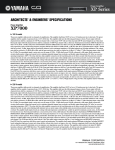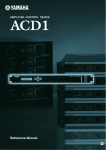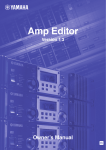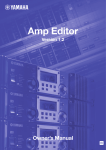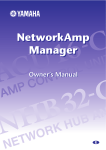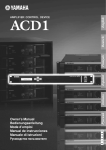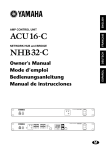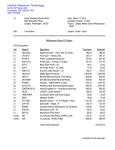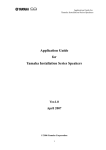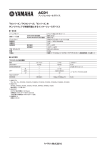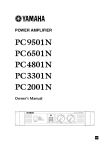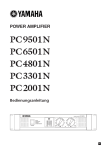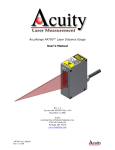Download Yamaha ACD1 Owner's Manual
Transcript
Owner’s Manual Bedienungsanleitung Mode d’emploi Manual de instrucciones Manuale di istruzioni Руководство пользователя EN DE FR ES IT RU Explanation of Graphical Symbols The lightning flash with arrowhead symbol within an equilateral triangle is intended to alert the user to the presence of uninsulated “dangerous voltage” within the product’s enclosure that may be of sufficient magnitude to constitute a risk of electric shock to persons. C A U TI ON RISK OF ELECTRIC SHOCK DO NOT OPEN CAUTION: TO REDUCE THE RISK OF ELECTRIC SHOCK, DO NOT REMOVE COVER (OR BACK). NO USER-SERVICEABLE PARTS INSIDE. REFER SERVICING TO QUALIFIED SERVICE PERSONNEL. The exclamation point within an equilateral triangle is intended to alert the user to the presence of important operating and maintenance (servicing) instructions in the literature accompanying the product. The above warning is located on the top of the unit. IMPORTANT SAFETY INSTRUCTIONS 1 2 3 4 5 6 7 8 9 10 Read these instructions. Keep these instructions. Heed all warnings. Follow all instructions. Do not use this apparatus near water. Clean only with dry cloth. Do not block any ventilation openings. Install in accordance with the manufacturer’s instructions. Do not install near any heat sources such as radiators, heat registers, stoves, or other apparatus (including amplifiers) that produce heat. Do not defeat the safety purpose of the polarized or grounding-type plug. A polarized plug has two blades with one wider than the other. A grounding type plug has two blades and a third grounding prong. The wide blade or the third prong are provided for your safety. If the provided plug does not fit into your outlet, consult an electrician for replacement of the obsolete outlet. Protect the power cord from being walked on or pinched particularly at plugs, convenience receptacles, and the point where they exit from the apparatus. 11 12 13 14 Only use attachments/accessories specified by the manufacturer. Use only with the cart, stand, tripod, bracket, or table specified by the manufacturer, or sold with the apparatus. When a cart is used, use caution when moving the cart/ apparatus combination to avoid injury from tip-over. Unplug this apparatus during lightning storms or when unused for long periods of time. Refer all servicing to qualified service personnel. Servicing is required when the apparatus has been damaged in any way, such as power-supply cord or plug is damaged, liquid has been spilled or objects have fallen into the apparatus, the apparatus has been exposed to rain or moisture, does not operate normally, or has been dropped. WARNING TO REDUCE THE RISK OF FIRE OR ELECTRIC SHOCK, DO NOT EXPOSE THIS APPARATUS TO RAIN OR MOISTURE. (UL60065_03) 2 ACD1 Owner’s Manual FCC INFORMATION (U.S.A.) 1. IMPORTANT NOTICE: DO NOT MODIFY THIS UNIT! This product, when installed as indicated in the instructions contained in this manual, meets FCC requirements. Modifications not expressly approved by Yamaha may void your authority, granted by the FCC, to use the product. 2. IMPORTANT: When connecting this product to accessories and/or another product use only high quality shielded cables. Cable/s supplied with this product MUST be used. Follow all installation instructions. Failure to follow instructions could void your FCC authorization to use this product in the USA. 3. NOTE: This product has been tested and found to comply with the requirements listed in FCC Regulations, Part 15 for Class “B” digital devices. Compliance with these requirements provides a reasonable level of assurance that your use of this product in a residential environment will not result in harmful interference with other electronic devices. This equipment generates/uses radio frequencies and, if not installed and used according to the instructions found in the users manual, may cause interference harmful to the opera- tion of other electronic devices. Compliance with FCC regulations does not guarantee that interference will not occur in all installations. If this product is found to be the source of interference, which can be determined by turning the unit “OFF” and “ON”, please try to eliminate the problem by using one of the following measures: Relocate either this product or the device that is being affected by the interference. Utilize power outlets that are on different branch (circuit breaker or fuse) circuits or install AC line filter/s. In the case of radio or TV interference, relocate/reorient the antenna. If the antenna lead-in is 300 ohm ribbon lead, change the lead-in to co-axial type cable. If these corrective measures do not produce satisfactory results, please contact the local retailer authorized to distribute this type of product. If you can not locate the appropriate retailer, please contact Yamaha Corporation of America, Electronic Service Division, 6600 Orangethorpe Ave, Buena Park, CA90620 The above statements apply ONLY to those products distributed by Yamaha Corporation of America or its subsidiaries. * This applies only to products distributed by YAMAHA CORPORATION OF AMERICA. COMPLIANCE INFORMATION STATEMENT (DECLARATION OF CONFORMITY PROCEDURE) Responsible Party : Yamaha Corporation of America Address : 6600 Orangethorpe Ave., Buena Park, Calif. 90620 Telephone : 714-522-9011 Type of Equipment : Amplifier Control Device Model Name : ACD1 This device complies with Part 15 of the FCC Rules. Operation is subject to the following two conditions: 1) this device may not cause harmful interference, and 2) this device must accept any interference received including interference that may cause undesired operation. See user manual instructions if interference to radio reception is suspected. * This applies only to products distributed by YAMAHA CORPORATION OF AMERICA. (FCC DoC) This product contains a battery that contains perchlorate material. Perchlorate Material—special handling may apply, See www.dtsc.ca.gov/hazardouswaste/perchlorate. * This applies only to products distributed by YAMAHA CORPORATION OF AMERICA. (Perchlorate) ADVARSEL! Lithiumbatteri—Eksplosionsfare ved fejlagtig håndtering. Udskiftning må kun ske med batteri af samme fabrikat og type. Levér det brugte batteri tilbage til leverandoren. VARNING Explosionsfara vid felaktigt batteribyte. Använd samma batterityp eller en ekvivalent typ som rekommenderas av apparattillverkaren. Kassera använt batteri enligt fabrikantens instruktion. VAROITUS Paristo voi räjähtää, jos se on virheellisesti asennettu. Vaihda paristo ainoastaan laitevalmistajan suosittelemaan tyyppiin. Hävitä käytetty paristo valmistajan ohjeiden mukaisesti. IMPORTANT NOTICE FOR THE UNITED KINGDOM Connecting the Plug and Cord WARNING: THIS APPARATUS MUST BE EARTHED IMPORTANT. The wires in this mains lead are coloured in accordance with the following code: GREEN-AND-YELLOW : EARTH BLUE : NEUTRAL BROWN : LIVE As the colours of the wires in the mains lead of this apparatus may not correspond with the coloured markings identifying the terminals in your plug proceed as follows: The wire which is coloured GREEN-and-YELLOW must be connected to the terminal in the plug which is marked by the letter E or by the safety earth symbol or colored GREEN or GREEN-and-YELLOW. The wire which is coloured BLUE must be connected to the terminal which is marked with the letter N or coloured BLACK. The wire which is coloured BROWN must be connected to the terminal which is marked with the letter L or coloured RED. • This applies only to products distributed by Yamaha Music U.K. Ltd. (class B) (3 wires) (lithium caution) NEDERLAND / THE NETHERLANDS • Dit apparaat bevat een lithium batterij voor geheugen backup. • This apparatus contains a lithium battery for memory backup. • Raadpleeg uw leverancier over de verwijdering van de batterij op het moment dat u het apparaat ann het einde van de levensduur of gelieve dan contact op te nemen met de vertegenwoordiging van Yamaha in uw land. • For the removal of the battery at the moment of the disposal at the end of life please consult your retailer or Yamaha representative office in your country. • Gooi de batterij niet weg, maar lever hem in als KCA. • Do not throw away the battery. Instead, hand it in as small chemical waste. (lithium disposal) ACD1 Owner’s Manual 3 PRECAUTIONS PLEASE READ CAREFULLY BEFORE PROCEEDING * Please keep this manual in a safe place for future reference. WARNING Always follow the basic precautions listed below to avoid the possibility of serious injury or even death from electrical shock, short-circuiting, damages, fire or other hazards. These precautions include, but are not limited to, the following: Power supply/Power cord Water warning • Only use the voltage specified as correct for the device. The required voltage is printed on the name plate of the device. • Use only the included power cord. If you intend to use the device in an area other than in the one you purchased, the included power cord may not be compatible. Please check with your Yamaha dealer. • Do not place the power cord near heat sources such as heaters or radiators, and do not excessively bend or otherwise damage the cord, place heavy objects on it, or place it in a position where anyone could walk on, trip over, or roll anything over it. • Be sure to connect to an appropriate outlet with a protective grounding connection. Improper grounding can result in electrical shock. Do not open • Do not open the device or attempt to disassemble the internal parts or modify them in any way. The device contains no user-serviceable parts. If it should appear to be malfunctioning, discontinue use immediately and have it inspected by qualified Yamaha service personnel. • Do not expose the device to rain, use it near water or in damp or wet conditions, or place containers on it containing liquids which might spill into any openings. If any liquid such as water seeps into the device, turn off the power immediately and unplug the power cord from the AC outlet. Then have the device inspected by qualified Yamaha service personnel. • Never insert or remove an electric plug with wet hands. If you notice any abnormality • If the power cord or plug becomes frayed or damaged, or if there is a sudden loss of sound during use of the device, or if any unusual smells or smoke should appear to be caused by it, immediately turn off the power switch, disconnect the electric plug from the outlet, and have the device inspected by qualified Yamaha service personnel. • If this device should be dropped or damaged, immediately turn off the power switch, disconnect the electric plug from the outlet, and have the device inspected by qualified Yamaha service personnel. CAUTION Always follow the basic precautions listed below to avoid the possibility of physical injury to you or others, or damage to the device or other property. These precautions include, but are not limited to, the following: Power supply/Power cord • Remove the electric plug from the outlet when the device is not to be used for extended periods of time, or during electrical storms. • When removing the electric plug from the device or an outlet, always hold the plug itself and not the cord. Pulling by the cord can damage it. • Before moving the device, remove all connected cables. • When setting up the device, make sure that the AC outlet you are using is easily accessible. If some trouble or malfunction occurs, immediately turn off the power switch and disconnect the plug from the outlet. Even when the power switch is turned off, electricity is still flowing to the product at the minimum level. When you are not using the product for a long time, make sure to unplug the power cord from the wall AC outlet. (5)-6 ACD1 Owner’s Manual • Do not expose the device to excessive dust or vibrations, or extreme cold or heat (such as in direct sunlight, near a heater, or in a car during the day) to prevent the possibility of panel disfiguration or damage to the internal components. • Do not place the device in an unstable position where it might accidentally fall over. Location 4 • If several of the devices are mounted in an EIA-compliant rack, carefully read the section “Precautions when rack-mounting the unit” on page 9. • Do not use the device in the vicinity of a TV, radio, stereo equipment, mobile phone, or other electric devices. Doing so may result in noise, both in the device itself and in the TV or radio next to it. 1/2 Handling caution Backup battery • Condensation can occur in the device due to rapid, drastic changes in ambient temperature—when the device is moved from one location to another, or air conditioning is turned on or off, for example. Using the device while condensation is present can cause damage. If there is reason to believe that condensation might have occurred, leave the device for several hours without turning on the power until the condensation has completely dried out. • Do not insert your fingers or hands in any gaps or openings on the device (ports, etc.). • Avoid inserting or dropping foreign objects (paper, plastic, metal, etc.) into any gaps or openings on the device (ports, etc.) If this happens, turn off the power immediately and unplug the power cord from the AC outlet. Then have the device inspected by qualified Yamaha service personnel. • Do not rest your weight on the device or place heavy objects on it, and avoid use excessive force on the buttons, switches or connectors. This device has a built-in backup battery that maintains data in internal memory even when the device’s power is switched off. The backup battery will eventually become depleted, however, and when that happens the contents of the internal memory will be lost.* To prevent loss of data be sure to replace the backup battery before it becomes fully depleted. When the remaining capacity of the backup battery becomes so low that it needs to be replaced a “Low Battery”, “Critical Battery” or “No Battery” message will appear on the display during operation or when the device is powered on. If either of these messages appears do not turn off the power and immediately transfer any data you want to save to a computer or other external storage device, then have qualified Yamaha service personnel replace the backup battery. The average life of the internal backup battery is approximately 5 years, depending on operating conditions. * Data items maintained in the internal memory by the backup battery are as follows: • Current scene parameters and number. • Device parameters (Device Setup, Utility, Network Setup, etc.). Yamaha cannot be held responsible for damage caused by improper use or modifications to the device, or data that is lost or destroyed. Always turn the power off when the device is not in use. The performance of components with moving contacts, such as switches, volume controls, and connectors, deteriorates over time. Consult qualifi ed Yamaha service personnel about replacing defective components. European models Purchaser/User Information specified in EN55103-1 and EN55103-2. Inrush Current: 45A Conforms to Environments: E1, E2 E3 and E4 ● SPECIAL NOTICES The illustrations and LCD screens as shown in this manual are for instructional purposes only, and may appear somewhat different from those on your instrument. • Windows is a registered trademark of Microsoft® Corporation in the United States and other countries. • The company names and product names in this manual are the trademarks or registered trademarks of their respective companies. For customers using the PC9500N, PC4800N, or PC3300N power amplifiers If your system connects the PC9500N, PC4800N, or PC3300N power amplifiers to the ACD1, there may be cases in which Amp Editor will not display the meters correctly for some power amplifiers. Please check whether this problem has been corrected for the power amplifier you’re using. If not, please contact your Yamaha dealer. [Checking for the correction] If the two alphabetical characters at the beginning of the serial number label on the back of the power amp are IL, IM, IN, IO, IP, IX, IY, IZ, or JH, and no green circular label is affixed immediately nearby it, then the product has not been corrected. For customers using the T5n, T4n, or T3n power amplifiers When monitoring or controlling the T5n, T4n, or T3n power amplifiers, set the GAIN switch of the T5n, T4n, or T3n to [26 dB] to avoid clipping if you plan to input signals with a maximum input level of +24 dBu. When the power amplifier is connected to the ACD1, the electronic volume control inside the amplifier will become effective, and the maximum input level will become +18 dBu if the GAIN switch has been set to [32 dB]. Included Accessories • AC power cord • Rubber feet x 4 • Euroblock connector (16P) • Owner’s Manual (this document) (5)-6 2/2 ACD1 Owner’s Manual 5 Contents Introduction ........................................................................................................7 Related manuals and software ................................................................................................ 7 Features of the ACD1 .............................................................................................................. 7 Terms....................................................................................................................................... 8 Supported amplifiers................................................................................................................ 8 Regarding firmware updates.................................................................................................... 8 Precautions when rack-mounting the unit................................................................................ 9 Preparation ............................................................................................................................ 10 Connection Examples .....................................................................................11 Connections with the PC-N or Tn series................................................................................ 12 Connections with the XP, XM, or XH series .......................................................................... 13 Connections with controllers from other manufacturers ........................................................ 13 Operations that can be performed from the panel .......................................14 Troubleshooting...............................................................................................15 Initializing the internal memory .............................................................................................. 15 6 ACD1 Owner’s Manual Introduction Thank you for purchasing the Yamaha ACD1 Amplifier Control Device. In order to take full advantage of the ACD1’s functionality and to ensure trouble-free operation, please read this owner’s manual carefully before use. After you have read the manual, keep it in a safe place for reference when needed. Related manuals and software This document explains mainly the initial connection. Manuals that contain detailed explanations of the ACD1 and Amp Editor, as well as the Amp Editor software itself, can be downloaded from the following page of the website. http://www.yamahaproaudio.com/downloads/ ● List of related manuals ACD1 Reference Manual Provides a detailed explanation of the ACD1’s panel operations, etc.. Amp Editor Installation Guide Explains the installation procedure for Amp Editor and the uninstallation procedure. Amp Editor Owner’s Manual Explains how to set up Amp Editor and the ACD1, and how to use Amp Editor. NOTE • In order to view the downloaded manuals, Adobe Reader must be installed in your computer. If you don’t have Adobe Reader, please access the Adobe Corporation’s website at the following URL, and download Adobe Reader (free of charge). http://www.adobe.com/ Features of the ACD1 The ACD1 is an amplifier control device with the following features. ■ Monitor and control amplifiers from Amp Editor The ACD1 and amplifiers connected to the ACD1 can be monitored and controlled from a LAN-connected computer in which the Amp Editor application software is installed. The ACD1 can also monitor the output signal of the connected amplifiers and control their power supply On/Standby status. ■ Monitor and control up to 40 amplifiers A single ACD1 unit is able to monitor and control up to 40 connected amplifiers (a maximum of eight XP/XM/XH series units, and a maximum of 32 PC-N/Tn series units can be connected). By connecting multiple ACD1 units in a single network, a larger number of amplifiers can be monitored and controlled via Amp Editor. ACD1 Owner’s Manual 7 Terms This section explains terminology specific to the ACD1. ■ Scene Settings such as power-on/standby or mute for each amplifier are called a “scene.” By recalling a scene, the saved settings can be immediately applied to the amplifiers. ■ Scene link Settings for simultaneously recalling scenes for multiple amplifiers within an area are called a “scene link.” By recalling a scene link, scenes can be simultaneously recalled for multiple amplifiers. Scene links can be created and recalled using Amp Editor. Supported amplifiers As of September 2009, the following amplifiers support connection with the ACD1. • XP series • XM series • XH series • PC-N series • Tn series : : : : : XP7000, XP5000, XP3500, XP2500, XP1000 XM4180, XM4080 XH200 PC9501N, PC6501N, PC4801N, PC3301N, PC2001N, PC9500N, PC4800N, PC3300N T5n, T4n, T3n * For the most recent information, refer to the following website. http://www.yamahaproaudio.com/ Regarding firmware updates The firmware version of the ACD1 itself can be checked from the ACD1’s panel and from Amp Editor. You can update the firmware via Amp Editor. For the update procedure, refer to the Amp Editor owner’s manual. You can download the latest firmware from the download page of the following Yamaha website. http://www.yamahaproaudio.com/downloads/ 8 ACD1 Owner’s Manual Precautions when rack-mounting the unit This unit will operate stably in an environmental temperature of 0–40°C. If you install this device together with multiple units of the same device or other devices in a EIA standard rack, the heat produced by the various devices may raise the ambient temperature inside the rack, resulting in inefficient performance. To ensure that the heat produced by this device can be dissipated appropriately, please ensure the following conditions when rackmounting it. • When mounting this device together with other heat-producing equipment such as power amplifiers, leave 1U or more space between it and other devices (including other ACD1 units). Install a ventilation panel in this vacant space or leave it open to ensure adequate cooling. • Leave the back of the rack open, and allow at least 10 cm of space between the rack and the wall and ceiling to ensure adequate cooling. If you’ve installed a fan kit, there may be cases in which closing the back of the rack will produce a greater cooling effect. For details, refer to the owner’s manual of your rack or fan kit. ■ When mounting the ACD1 together with compatible amplifiers 1) When mounting only one ACD1 in a rack 2) When mounting multiple ACD1 units in a rack ACD1 ACD1 ventilation panel ventilation panel amplifier amplifier amplifier amplifier amplifier ventilation panel ACD1 ventilation panel amplifier amplifier amplifier amplifier amplifier • Do not mount another ACD1 unit or amplifier above or below the ACD1. CAUTION amplifier ACD1 ACD1 ACD1 amplifier amplifier ACD1 Owner’s Manual 9 Preparation Connecting the AC power cable • Be sure to turn all devices OFF before connecting AC mains power. CAUTION First plug the female-connector end of the included AC cable into the [AC IN] socket on the rear panel of the ACD1, then plug the male plug into an appropriate AC outlet. Be sure to use an AC outlet of the voltage specified for the device. Turning the power on and off CAUTION • To prevent the initial power-on surge from generating a large noise spike or damaging your speaker system, turn the devices on in the following order: audio sources, mixer (such as M7CL or PM5D), ACD1, and finally power amplifiers. Reverse this order when turning power off. • If you power-on the amplifier before the ACD1, the amplifier may be ready before the mute or level setting of the ACD1 becomes effective, resulting in an unexpected loud sound. • If you power-off the ACD1 before your XP/XM/XH series amplifiers, the amplifier’s settings will return to their default state. 1. Press the [POWER] switch to power-on the ACD1. 2. Press the [POWER] switch again to turn off the power. NOTE • The settings at the time you powered-off are remembered. When you turn on the power again, the unit will start up with the same settings. You can use the “Last Mem. Resume” setting to set up the unit so that at startup it will recall the scene number selected before you turned off the power to the device. • Do not power-off the unit while its LCD indicates “Do not turn off!” Otherwise, a malfunction may occur. CAUTION • A small amount of current is flowing even when the power switch is off. If you will not be using this device for an extended period of time, be sure to disconnect the power plug from the AC outlet. CAUTION 10 ACD1 Owner’s Manual Connection Examples To construct an amplifier control system, connect the ACD1 to your amplifiers and computer as follows. Amp Editor Ethernet cable Ethernet cable Network switch D-Sub cable Ethernet cable ACD1 Tn series XP series Tn series XM series PC-N series XH series Maximum of 8 amps Maximum of 32 amps Ethernet straight cable TXn series NOTE Connections between the ACD1 and computer • Use a network switch that is compatible with 100Base-TX/10Base-T. • The network switch is not necessary if the computer and ACD1 are directly connected. • The Ethernet cable between the computer or network switch and the ACD1 can be no longer than 100 meters. However, due to variations in computers, network switches, and cable quality, proper operation at the maximum length cannot be guaranteed in some cases. • In the United States or Canada, the Ethernet cables that connect the ACD1 to the computer or network switch should be STP cables in order to avoid electromagnetic interference. • Since the ACD1 supports Auto MDI/MDI-X, it will automatically detect whether the connected cable is of the straight type or crossover type, and will configure itself to create the appropriate connection. Therefore, you can use either a straight or crossover cable. ACD1 Owner’s Manual 11 Connection Examples Connections with the PC-N or Tn series The ACD1 allows daisy-chain connection of up to 32 PC-N or Tn series units using Ethernet cable via the [DATA PORT] connector. Connection procedure 1. Make the appropriate AMP ID and terminator settings using the [AMP ID] switches located on the rear panel of the connected amplifiers. Specify a different AMP ID for each amplifier that is connected to the same ACD1. The AMP ID will be the total of the values of the switches that are set to ON. Set the T (terminator) switch to ON for the last amplifier in the daisy-chain. In the example shown in this illustration, the AMP ID is 28 (16+8+4) and the terminator is ON. 2. Use Ethernet cables to daisy-chain the ACD1’s [DATA PORT] connector and the [DATA PORT] connector of the amplifiers, as shown in the illustration. It is not necessary to connect the amplifiers in order of their AMP ID, but connecting them in this order will make it easier to determine the AMP ID without looking at the rear panel. ACD1 DATA PORT connector AMP ID : 0 T : OFF DATA PORT AMP ID : 1 T : OFF DATA PORT AMP ID : 2 T : OFF DATA PORT AMP ID : 31 (Maximum of 32 amps) T : ON NOTE • The total maximum length of Ethernet cable that can be used is 500 meters. • Use CAT5 or higher UTP straight Ethernet cable or STP straight Ethernet cable that connects all eight pins. • Both PC-N series units and Tn series units can be connected to the same ACD1. • You can make connections to either of the two [DATA PORT] connectors on the amplifier. 12 ACD1 Owner’s Manual Connection Examples Connections with the XP, XM, or XH series Up to eight XP, XM, or XH series units can be connected to the ACD1 via the [MONITOR/REMOTE] connectors. Connection procedure 1. Connect the ACD1’s [MONITOR/REMOTE] connector to the [MONITOR/REMOTE] connector of the XP, XM, or XH series unit using a D-Sub 15-pin cable (such as a commercially-available VGA cable for a computer monitor) as shown below. ACD1 MONITOR/REMOTE connector MONITOR/ REMOTE connector NOTE XP series AMP ID : 35 XM series AMP ID : 34 XH series AMP ID : 33 Maximum of 8 amps • Use a D-sub straight cable that has all fifteen pins connected. • The maximum D-sub cable length that can be used is 50 meters. Connections with controllers from other manufacturers An Ethernet-compatible controller such as AMX or Crestron can be connected, allowing remote control of the ACD1 and the amplifiers connected to the ACD1. If you connect an Ethernet-compatible remote controller, you must set the ACD1 IP Port number by using [6.Network Setup] → [IP Ctrl Port #] on the ACD1 unit. Alternatively, in Amp Editor you can click the [Device Setup] menu command [IP Control Port No.] and open the “IP Control Port No.” dialog box, and then specify the ACD1’s IP port number in the “External Device Port” field. For details of the remote control communication protocol, please refer to the TXn/ACD1 remote control protocol specification provided on the website. http://www.yamahaproaudio.com/ ACD1 Owner’s Manual 13 Operations that can be performed from the panel The following operations can be performed from the ACD1’s front panel. NOTE • For details, refer to the ACD1 Reference Manual. • Before use, remove the transparent protective film that was applied to the LCD prior to shipment from the factory. Category 1. Scene 2. Amp Control Sub category Recall Recalls a scene on the specified amplifier. Store Saves a scene for the specified amplifier. Standby/On Switches the power of the specified amplifier between On and Standby. Mute Mutes or unmutes the channel of the specified amplifier. Attenuation Adjusts the channel attenuator value of the specified amplifier. (PC-N and Tn series only) 3. Output Monitor 4. Device Setup 5. Utility 6. Network Setup 14 ACD1 Owner’s Manual Operation performed Displays the output level of the specified amplifier. Device ID Specifies the ACD1’s Device ID address. Device Label Displays the name of the ACD1 assigned by Amp Editor. Identify Blinks the “Identify” icon of the corresponding ACD1 in Amp Editor. Battery Displays the state of the ACD1’s internal backup battery. Firmware Ver. Displays the ACD1’s firmware version. LCD Backlight Selects whether the ACD1’s LCD backlight will be always lit (ON) or lit only during operation (Auto OFF). Panel Operation Restricts panel operations of the ACD1. Scene Recall Specifies whether scene recall from the ACD1’s panel is enabled (Enable) or disabled (Disable). EMG Scene Setup Specifies the scene number that will be recalled when the EMG (Emergency) signal is received from an external controller. Last Mem. Resume Specifies whether the ACD1 will start up with the settings that were in effect when the power was last turned off (ON) or whether it will start up by recalling the amp’s scene number that was in effect when the power was last turned off (OFF). Clock Setup Sets the date and time of the ACD1’s internal clock. GPI Calibration Calibrates the [GPI IN] connector input voltage. IP Address Mode Selects whether the ACD1’s IP address will be set automatically from Amp Editor (DHCP) or set manually (Manual). IP Address Specifies the ACD1’s IP address. MAC Address Displays the ACD1’s MAC address. IP Ctrl Port # Specifies the port number used when controlling the ACD1 via Ethernet from an external controller such as AMX/Crestron. Troubleshooting Symptom All scene data saved in the ACD1 has disappeared. Possible causes Response The power was turned off while the ACD1’s data was being saved. Synchronize with Amp Editor once again to transmit the settings from Amp Editor. The backup battery has run down. Check [5.Utility] → [Battery] for the state of the backup battery. If the state shows any message other than “OK,” ask qualified Yamaha service personnel to replace the backup battery. An alert message is displayed. An incorrect or abnormal connection with the amplifier or other alert event related to the connections has occurred. For details on the meaning of each alert message and the appropriate measures to take, refer to the Amp Editor Owner’s Manual. Panel operations are not accepted. The unit is locked. For details, refer to “5.Utility” in the ACD1 reference manual. A scene can be saved but not recalled. “Scene Recall” is set to “Disable.” Access [5.Utility], then [SceneRecall] and set it to “Enable.” The LCD is not backlit. “LCD Backlight” is set to “Auto OFF.” To set the unit so that the LCD remains backlit at all times, access [5.Utility], then [LCD Backlight] and set it to “ON.” Initializing the internal memory You can initialize the ACD1’s internal memory. NOTE • The log data is preserved even if you execute initialization. • When you initialize the internal memory, the content that had been saved in memory (scenes for each amp, and ACD1 settings) will be lost. CAUTION Use caution when performing the following steps. 1. Power-off the ACD1. 2. While holding down the [BACK] button, turn the power on. 3. Press the [▲INC/YES] button to initialize the internal memory. When initialization is completed, the ACD1 will automatically restart. • During initialization, the message “Do not turn off!” will be shown in the display. Never power-off the amplifier while this message is displayed. CAUTION ACD1 Owner’s Manual 15 Information for Users on Collection and Disposal of Old Equipment EN This symbol on the products, packaging, and/or accompanying documents means that used electrical and electronic products should not be mixed with general household waste. For proper treatment, recovery and recycling of old products, please take them to applicable collection points, in accordance with your national legislation and the Directives 2002/96/EC. By disposing of these products correctly, you will help to save valuable resources and prevent any potential negative effects on human health and the environment which could otherwise arise from inappropriate waste handling. For more information about collection and recycling of old products, please contact your local municipality, your waste disposal service or the point of sale where you purchased the items. [For business users in the European Union] If you wish to discard electrical and electronic equipment, please contact your dealer or supplier for further information. [Information on Disposal in other Countries outside the European Union] This symbol is only valid in the European Union. If you wish to discard these items, please contact your local authorities or dealer and ask for the correct method of disposal. Verbraucherinformation zur Sammlung und Entsorgung alter Elektrogeräte DE Befindet sich dieses Symbol auf den Produkten, der Verpackung und/oder beiliegenden Unterlagen, so sollten benutzte elektrische Geräte nicht mit dem normalen Haushaltsabfall entsorgt werden. In Übereinstimmung mit Ihren nationalen Bestimmungen und den Richtlinien 2002/96/EC, bringen Sie alte Geräte bitte zur fachgerechten Entsorgung, Wiederaufbereitung und Wiederverwendung zu den entsprechenden Sammelstellen. Durch die fachgerechte Entsorgung der Elektrogeräte helfen Sie, wertvolle Ressourcen zu schützen und verhindern mögliche negative Auswirkungen auf die menschliche Gesundheit und die Umwelt, die andernfalls durch unsachgerechte Müllentsorgung auftreten könnten. Für weitere Informationen zum Sammeln und Wiederaufbereiten alter Elektrogeräte, kontaktieren Sie bitte Ihre örtliche Stadt- oder Gemeindeverwaltung, Ihren Abfallentsorgungsdienst oder die Verkaufsstelle der Artikel. [Information für geschäftliche Anwender in der Europäischen Union] Wenn Sie Elektrogeräte ausrangieren möchten, kontaktieren Sie bitte Ihren Händler oder Zulieferer für weitere Informationen. [Entsorgungsinformation für Länder außerhalb der Europäischen Union] Dieses Symbol gilt nur innerhalb der Europäischen Union. Wenn Sie solche Artikel ausrangieren möchten, kontaktieren Sie bitte Ihre örtlichen Behörden oder Ihren Händler und fragen Sie nach der sachgerechten Entsorgungsmethode. FR Information concernant la Collecte et le Traitement des déchets d’équipements électriques et électroniques Le symbole sur les produits, l’emballage et/ou les documents joints signifie que les produits électriques ou électroniques usagés ne doivent pas être mélangés avec les déchets domestiques habituels. Pour un traitement, une récupération et un recyclage appropriés des déchets d’équipements électriques et électroniques, veuillez les déposer aux points de collecte prévus à cet effet, conformément à la réglementation nationale et aux Directives 2002/96/EC. En vous débarrassant correctement des déchets d’équipements électriques et électroniques, vous contribuerez à la sauvegarde de précieuses ressources et à la prévention de potentiels effets négatifs sur la santé humaine qui pourraient advenir lors d’un traitement inapproprié des déchets. Pour plus d’informations à propos de la collecte et du recyclage des déchets d’équipements électriques et électroniques, veuillez contacter votre municipalité, votre service de traitement des déchets ou le point de vente où vous avez acheté les produits. [Pour les professionnels dans l’Union Européenne] Si vous souhaitez vous débarrasser des déchets d’équipements électriques et électroniques veuillez contacter votre vendeur ou fournisseur pour plus d’informations. [Information sur le traitement dans d’autres pays en dehors de l’Union Européenne] Ce symbole est seulement valables dans l’Union Européenne. Si vous souhaitez vous débarrasser de déchets d’équipements électriques et électroniques, veuillez contacter les autorités locales ou votre fournisseur et demander la méthode de traitement appropriée. ACD1 Owner’s Manual ES Información para Usuarios sobre Recolección y Disposición de Equipamiento Viejo Este símbolo en los productos, embalaje, y/o documentación que se acompañe significa que los productos electrónicos y eléctricos usados no deben ser mezclados con desechos hogareños corrientes. Para el tratamiento, recuperación y reciclado apropiado de los productos viejos, por favor llévelos a puntos de recolección aplicables, de acuerdo a su legislación nacional y las directivas 2002/96/EC. Al disponer de estos productos correctamente, ayudará a ahorrar recursos valiosos y a prevenir cualquier potencial efecto negativo sobre la salud humana y el medio ambiente, el cual podría surgir de un inapropiado manejo de los desechos. Para mayor información sobre recolección y reciclado de productos viejos, por favor contacte a su municipio local, su servicio de gestión de residuos o el punto de venta en el cual usted adquirió los artículos. [Para usuarios de negocios en la Unión Europea] Si usted desea deshacerse de equipamiento eléctrico y electrónico, por favor contacte a su vendedor o proveedor para mayor información. [Información sobre la Disposición en otros países fuera de la Unión Europea] Este símbolo sólo es válidos en la Unión Europea. Si desea deshacerse de estos artículos, por favor contacte a sus autoridades locales y pregunte por el método correcto de disposición. IT Informazioni per gli utenti sulla raccolta e lo smaltimento di vecchia attrezzatura Questo simbolo sui prodotti, sull’imballaggio, e/o sui documenti che li accompagnano significa che i prodotti elettriche e elettroniche non dovrebbero essere mischiati con i rifiuti domestici generici. Per il trattamento, recupero e riciclaggio appropriati di vecchi prodotti, li porti, prego, ai punti di raccolta appropriati, in accordo con la Sua legislazione nazionale e le direttive 2002/96/CE. Smaltendo correttamente questi prodotti, Lei aiuterà a salvare risorse preziose e a prevenire alcuni potenziali effetti negativi sulla salute umana e l’ambiente, che altrimenti potrebbero sorgere dal trattamento improprio dei rifiuti. Per ulteriori informazioni sulla raccolta e il riciclaggio di vecchi prodotti, prego contatti la Sua amministrazione comunale locale, il Suo servizio di smaltimento dei rifiuti o il punto vendita dove Lei ha acquistato gli articoli. [Per utenti imprenditori dell’Unione europea] Se Lei desidera disfarsi di attrezzatura elettrica ed elettronica, prego contatti il Suo rivenditore o fornitore per ulteriori informazioni. [Informazioni sullo smaltimento negli altri Paesi al di fuori dell’Unione europea] Questo simbolo è validi solamente nell’Unione europea. Se Lei desidera disfarsi di questi articoli, prego contatti le Sue autorità locali o il rivenditore e richieda la corretta modalità di smaltimento. ACD1 Owner’s Manual MEMO ACD1 Owner’s Manual For details of products, please contact your nearest Yamaha representative or the authorized distributor listed below. Pour plus de détails sur les produits, veuillez-vous adresser à Yamaha ou au distributeur le plus proche de vous figurant dans la liste suivante. NORTH AMERICA CANADA Yamaha Canada Music Ltd. 135 Milner Avenue, Scarborough, Ontario, M1S 3R1, Canada Tel: 416-298-1311 U.S.A. Yamaha Corporation of America 6600 Orangethorpe Ave., Buena Park, Calif. 90620, U.S.A. Tel: 714-522-9011 CENTRAL & SOUTH AMERICA MEXICO Yamaha de México S.A. de C.V. Calz. Javier Rojo Gómez #1149, Col. Guadalupe del Moral C.P. 09300, México, D.F., México Tel: 55-5804-0600 Die Einzelheiten zu Produkten sind bei Ihrer unten aufgeführten Niederlassung und bei Yamaha Vertragshändlern in den jeweiligen Bestimmungsländern erhältlich. Para detalles sobre productos, contacte su tienda Yamaha más cercana o el distribuidor autorizado que se lista debajo. ASIA POLAND Yamaha Music Europe GmbH Branch Sp.z o.o. Oddzial w Polsce ul. 17 Stycznia 56, PL-02-146 Warszawa, Poland Tel: 022-868-07-57 THE NETHERLANDS/ BELGIUM/LUXEMBOURG Yamaha Music Europe Branch Benelux Clarissenhof 5-b, 4133 AB Vianen, The Netherlands Tel: 0347-358 040 FRANCE Yamaha Musique France BP 70-77312 Marne-la-Vallée Cedex 2, France Tel: 01-64-61-4000 ITALY Yamaha Musica Italia S.P.A. Combo Division Viale Italia 88, 20020 Lainate (Milano), Italy Tel: 02-935-771 SPAIN/PORTUGAL BRAZIL Yamaha Musical do Brasil Ltda. Rua Joaquim Floriano, 913 - 4' andar, Itaim Bibi, CEP 04534-013 Sao Paulo, SP. BRAZIL Tel: 011-3704-1377 Yamaha Música Ibérica, S.A. Ctra. de la Coruna km. 17, 200, 28230 Las Rozas (Madrid), Spain Tel: 91-639-8888 SWEDEN ARGENTINA Yamaha Music Latin America, S.A. Sucursal de Argentina Olga Cossettini 1553, Piso 4 Norte Madero Este-C1107CEK Buenos Aires, Argentina Tel: 011-4119-7000 PANAMA AND OTHER LATIN AMERICAN COUNTRIES/ CARIBBEAN COUNTRIES Yamaha Music Latin America, S.A. Torre Banco General, Piso 7, Urbanización Marbella, Calle 47 y Aquilino de la Guardia, Ciudad de Panamá, Panamá Tel: +507-269-5311 EUROPE THE UNITED KINGDOM Yamaha Music U.K. Ltd. Sherbourne Drive, Tilbrook, Milton Keynes, MK7 8BL, England Tel: 01908-366700 Yamaha Scandinavia AB J. A. Wettergrens Gata 1, Box 30053 S-400 43 Göteborg, Sweden Tel: 031 89 34 00 DENMARK YS Copenhagen Liaison Office Generatorvej 6A, DK-2730 Herlev, Denmark Tel: 44 92 49 00 NORWAY Norsk filial av Yamaha Scandinavia AB Grini Næringspark 1, N-1345 Østerås, Norway Tel: 67 16 77 70 SWITZERLAND/LIECHTENSTEIN Yamaha Music Europe GmbH Branch Switzerland in Zürich Seefeldstrasse 94, 8008 Zürich, Switzerland Tel: 01-383 3990 AUSTRIA Yamaha Music Europe GmbH Branch Austria Schleiergasse 20, A-1100 Wien, Austria Tel: 01-60203900 CZECH REPUBLIC/SLOVAKIA/ HUNGARY/SLOVENIA Yamaha Music Europe GmbH Branch Austria Schleiergasse 20, A-1100 Wien, Austria Tel: 01-602039025 Yamaha Music & Electronics (China) Co.,Ltd. 2F, Yunhedasha, 1818 Xinzha-lu, Jingan-qu, Shanghai, China Tel: 021-6247-2211 INDIA Yamaha Music India Pvt. Ltd. 5F Ambience Corporate Tower Ambience Mall Complex Ambience Island, NH-8, Gurgaon-122001, Haryana, India Tel: 0124-466-5551 INDONESIA PT. Yamaha Music Indonesia (Distributor) PT. Nusantik Gedung Yamaha Music Center, Jalan Jend. Gatot Subroto Kav. 4, Jakarta 12930, Indonesia Tel: 21-520-2577 KOREA Yamaha Music Korea Ltd. 8F, 9F, Dongsung Bldg. 158-9 Samsung-Dong, Kangnam-Gu, Seoul, Korea Tel: 080-004-0022 MALAYSIA Yamaha Music Malaysia, Sdn., Bhd. Lot 8, Jalan Perbandaran, 47301 Kelana Jaya, Petaling Jaya, Selangor, Malaysia Tel: 3-78030900 SINGAPORE Yamaha Music Asia Pte., Ltd. #03-11 A-Z Building 140 Paya Lebor Road, Singapore 409015 Tel: 747-4374 TAIWAN Yamaha KHS Music Co., Ltd. 3F, #6, Sec.2, Nan Jing E. Rd. Taipei. Taiwan 104, R.O.C. Tel: 02-2511-8688 THAILAND RUSSIA Yamaha Music (Russia) Office 4015, entrance 2, 21/5 Kuznetskii Most street, Moscow, 107996, Russia Tel: 495 626 0660 OTHER EUROPEAN COUNTRIES Yamaha Music Europe GmbH Siemensstraße 22-34, 25462 Rellingen, Germany Tel: +49-4101-3030 GERMANY Yamaha Music Europe GmbH Siemensstraße 22-34, 25462 Rellingen, Germany Tel: 04101-3030 THE PEOPLE’S REPUBLIC OF CHINA AFRICA Yamaha Corporation, Asia-Pacific Music Marketing Group Nakazawa-cho 10-1, Naka-ku, Hamamatsu, Japan 430-8650 Tel: +81-53-460-2313 MIDDLE EAST TURKEY/CYPRUS Yamaha Music Europe GmbH Siemensstraße 22-34, 25462 Rellingen, Germany Tel: 04101-3030 OTHER COUNTRIES Yamaha Music Gulf FZE LOB 16-513, P.O.Box 17328, Jubel Ali, Dubai, United Arab Emirates Tel: +971-4-881-5868 Siam Music Yamaha Co., Ltd. 4, 6, 15 and 16th floor, Siam Motors Building, 891/1 Rama 1 Road, Wangmai, Pathumwan, Bangkok 10330, Thailand Tel: 02-215-2626 OTHER ASIAN COUNTRIES Yamaha Corporation, Asia-Pacific Music Marketing Group Nakazawa-cho 10-1, Naka-ku, Hamamatsu, Japan 430-8650 Tel: +81-53-460-2317 OCEANIA AUSTRALIA Yamaha Music Australia Pty. Ltd. Level 1, 99 Queensbridge Street, Southbank, Victoria 3006, Australia Tel: 3-9693-5111 COUNTRIES AND TRUST TERRITORIES IN PACIFIC OCEAN Yamaha Corporation, Asia-Pacific Music Marketing Group Nakazawa-cho 10-1, Naka-ku, Hamamatsu, Japan 430-8650 Tel: +81-53-460-2313 HEAD OFFICE Yamaha Corporation, Pro Audio & Digital Musical Instrument Division Nakazawa-cho 10-1, Naka-ku, Hamamatsu, Japan 430-8650 Tel: +81-53-460-2441 PA24 Yamaha Pro Audio global web site: http://www.yamahaproaudio.com/ Yamaha Manual Library http://www.yamaha.co.jp/manual/ U.R.G., Pro Audio & Digital Musical Instrument Division, Yamaha Corporation © 2009 Yamaha Corporation WM15360 909POCP?.?-02B0 Printed in Japan
This document in other languages
- română: Yamaha ACD1
- français: Yamaha ACD1
- español: Yamaha ACD1
- Deutsch: Yamaha ACD1
- русский: Yamaha ACD1
- Nederlands: Yamaha ACD1
- dansk: Yamaha ACD1
- polski: Yamaha ACD1
- čeština: Yamaha ACD1
- svenska: Yamaha ACD1
- italiano: Yamaha ACD1
- português: Yamaha ACD1
- Türkçe: Yamaha ACD1
- suomi: Yamaha ACD1





















